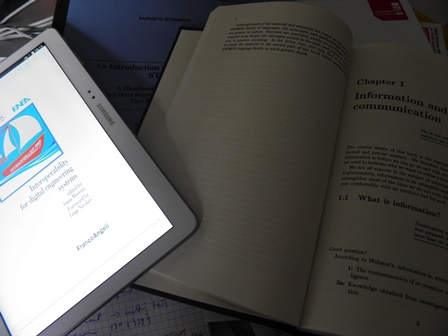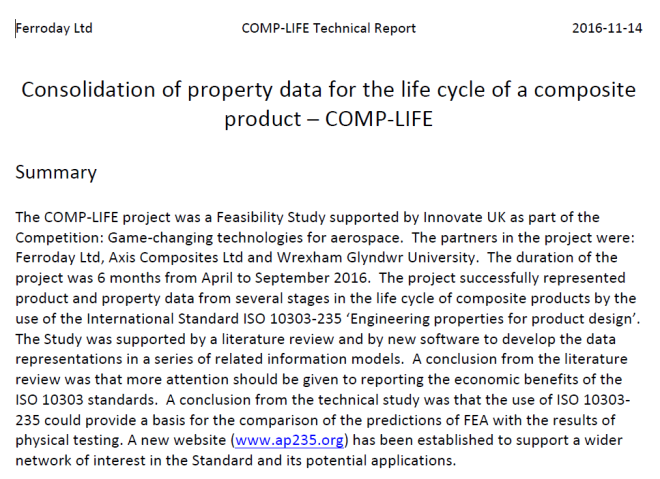The close-out Technical Report to the InnovateUK funded COMP-LIFE project is now available read.
Author: Alison McMillan
Standardised Digital Representation of the Measurement of Engineering Properties
Scenarios that have demonstrated the scope of ISO 10303-235
Engineering properties and materials information
by Norman Swindells, Ferroday Ltd
Introduction
ISO 10303-235 is a part of the family of standards for digital product data representation and exchange that have been developed over the last 30 years in the global project managed by the ISO Technical Committee 184, Sub-committee 4 (ISO/ TC184/SC4). The Standard is a computer-processable information model that enables the digital representation of any property of any product measured by any method. It has many representations in common with several other standards in the family to provide for the representation of property data across the whole life cycle of a product from conceptual design through to disposal. This is the standard that is being used for the COMP-LIFE Project.
For the complete document please follow this link: Demonstration scenarios_20160706
Building Information Model and Health Information Systems
Hello again,
today I’ve added some information on two examples with some similarity to STEP, and which have a much higher popular “presence”. These are the Building Information Model (BIM) and Health Information Systems.
The Building Information Model has had a dramatic uptake in the UK in the past couple of years: this is because the UK Government has first encouraged it through increasing awareness and training and then mandated it for public purse construction projects. The most visible organisation providing BIM compliant software is buildingSMART, which has grown out of an association, and as such has an open ethos.
In regard to Health Information Systems, I don’t see the same level of integration. I’ve google searched and found a number of references to health information systems, but the interesting thing is that they don’t seem to cross-reference each other, and the only site that mentions ISO standards for such systems is the ISO site itself. The company 3M seems to have a very big footprint in the sector, providing software supporting health data. The lack of any reference to ISO in the 3M literature leaves me wondering about monopoly power and access in poorer countries.
Some of you reading this blog will know more about this than I do – please do feel free to comment.
Thanks,
Alison
News on the COMP-LIFE blog-web space
Hello all,

for today I am going to draw your attention to a number of changes and developments in this space. I’m afraid my work-load has been lumpy, and that is why I haven’t posted anything for a while, and now there are several things all at once.
I’ve modified the style of the COMP-LIFE web, because for an evolving website, it is useful to have sub-levels in menus. It seems that not all wordpress style templates are created with that capability.
I’ve added a new web-page An Ignoramus’s Guide to STEP? which is really is intended as a page for resource and reference links. Some of the books and websites that Norman has pointed out to me are referenced there. I will add to this page continuously – if there is anything that you think I should know about, tell me, and I will add that as well.
I’ve started a new page and sub-page structure called Strategies for Elevating STEP?, which is where I intend to put observations and discussion of relevant examples. For the moment this includes Three types of STEP user, where I propose that in addition to the expert and the end-user there is a role for a marketer, who would be the glue that brings the two together and elevates awareness of the value of using STEP. For such a role there would also need to be an education and career structure, and that is something else that we should be thinking about. There are a few other links under the Strategies heading, but nothing particularly well developed yet.
Finally, I would like to say to you all, please get in touch. Please tell me what you think, or just acknowledge that you have read this garbage…! I’d also be very glad if you circulated this, or pages within the website, to people in your general network. Those who find it interesting can then follow the site to receive updates, post their own comments, or set out their wish-lists.
Alison
Are ISO Standards for Engineering Data fit for purpose?
Almost everyone these days, if asked to name an ISO standard, would think of ISO 9001, and most people would be able to say that having a “Standard” allows more effective exchange of information. For exchange of engineering data between applications, has ISO really delivered:
- Are the ISO standards sufficiently widely known, are they accessible?
- Are they being applied – and if so, are they the most effective and most used data exchange protocol?
- What metrics are being collected about usage levels, cost of adoption versus savings through their usage, and other impacts of adoption or non-adoption?
STEP (ISO 10303)
The COMP-LIFE project is primarily interested in ISO 10303 (STEP), and the particular parts ISO 10303-45 (Materials) and ISO 10303-235 (Materials information for the design and verification of products). Building on these, and others, we will be looking at the potential needs surrounding data capture of through-life composite material engineering component data.
Accessibility
A key question in accessibility, is that users know that the standard exists, that the standard is implemented in the software tools that the users use, and that those who develop the software tools have access to the definition of the standard.
On a simple level, accessibility implies publication. For book publications there is a system, ISBN, which means that the publication can always be found. If one copyright library burns down, the publication will be held in duplicate at another. How robust is the accessibility of the ISO standards? Is there an ISO standard for the maintenance of publication systems and platforms?
On another level, accessibility implies price. In the software industry, if you want everyone to adopt something, you provide it free at the point of use. Just look at the examples of GNU, Firefox, Wikipedia, and so on. Pricing, if applied at all, could be on the basis of donation, or a charge that represents the cost of reproduction, handling and postage, rather than on the value of the intellectual property of the content. Like many academic journal papers, ISO standards are developed by volunteers or those funded by the public purse. There will be an increasing demand for publicly funded content to be made available in an open access format, or for a fair price.
Application
I really have nothing to say on this subject yet. I’d be very happy to hear your views, readers of this blog.
Metrics
This is another aspect on which I would value your opinions.
Conclusion
I’m at the start of a feasibility study, and having lifted the hood on the ISO 10303 standards, I’m somewhat concerned about the status of what I find. For the onward activities of both the feasibility study, and any follow-on project planning, I am concerned about building on unstable ground.
I really would value input and opinions from readers, particularly those who are direct users of standards and software vendors of software which uses STEP data for input or output.
Feedback
Please post feedback to this post. Please follow the blog if you would like to be involved.
COMP-LIFE: WP 5 Data management and procedures
Within the COMP-LIFE project, Wrexham Glyndwr University’s most significant involvement is in WP5, entitled “Data management and procedures”. This task has started and is due to report in June 2016.
WP Objectives
- To develop procedures and recommendations on best practice for data management with ISO 10303.
Description of the work
- Literature and web search for review and related uses of ISO 10303 and BIM
- Comparison of review of related situations with requirements for design ad manufacture of composite products
- Identification of costs, benefits and requirements for the adoption of ISO 10303 methods and technologies for composite products
Initial thoughts
I visited the ISO standards website, with a view to finding out how the standards are managed as a whole, and to download and read some of the relevant standards within the ISO 10303 area. I’ve been particularly directed to view ISO 10303-45 and ISO 10303-235.
The ISO website seems to have been designed for those who know what they are looking for: it’s not for the faint-hearted. The most recent standard for ISO 10303-45 is ISO 10303-45:2014, but this is not published here yet.
I’m left thinking that if a standard is supposed to help all practitioners to work together to the same format, then that standard needs to be more effectively communicated. There is a long way to go yet!
COMP-LIFE Project is Launched
COMP-LIFE is an Innovate UK feasibility project, focusing on data modelling and data interoperability for composite materials. The idea is to be able to capture all forms of data: shape parametric data, test data, inspection and NDT data, measured at any point in the component’s life. The launch meeting was held on Monday 18th April.
The project lead is an SME called Ferroday, which specialises in material data modelling and data systems. There are two other partners: Axis Composites – an SME spinout from Ulster University’s composites research group, and Wrexham Glyndwr University‘s Analytical Decision Making Research Group.
Feasibility projects are short studies, in this case six months, with a view to applying for a more substantial project later in the year. The more substantial project would normally be compromised of more partners, and we looking now to engage with Tier 1 companies, composite supply-chain manufacturing companies, companies specialising in composite testing, the Catapult network, and any other interested parties which have an interest in the COMP-LIFE aspirations.
Please follow our blogs over the coming months, or get in touch directly.
Welcome to the COMP-LIFE project blog
This is a short welcome page, because at the moment the COMP-LIFE project has only just begun and we are still assembling all our static publicity information.
On the other hand, at the “feasibility stage” the project will be building up knowledge and data in preparation for broader application later. We will need to expand our network of contacts, and keep you informed about progress and how you might participate in due course. So this is the purpose of the blog.
Please follow us to stay informed.
Alison

